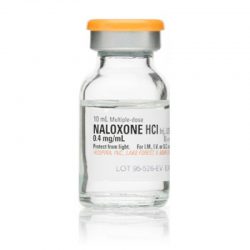The term opioid blocker is just another name for opioid antagonists. There are several different types of opioid blockers which can be used to create different results. These medications work by binding to the opioid receptors in the brain, the same way agonists like oxycodone, hydrocodone, heroin, and methadone do. However, the former substances bind to these receptors more strongly than agonists do. They also do not activate the receptors, nor do they cause euphoria or any other intoxication effects. In essence, opioid blockers can protect individuals addicted to narcotics from many of the dangerous side effects caused by their drug abuse.
Naloxone: The Overdose Treatment

Naloxone is used for treating opioid overdose.
Naloxone, according to the NLM, “works by blocking the effects of opiates to relieve dangerous symptoms caused by high levels of opiates in the blood.” When a person takes a high dose of an opioid drug, they are often in danger of overdosing and experiencing its subsequent, harmful effects. These effects can include:
- Slowed, labored, or no breathing
- Respiratory failure
- Heart failure
- Brain damage
- Coma
- Death
When a person overdoses on opioids, they should be taken to the hospital immediately. There, they will be given a naloxone shot which will counteract the dangerous effects of these drugs. The naloxone will bind to the opioid receptors, effectively shutting down the intoxication and overdose effects. This can be quite intense, and many individuals describe the effects of a naloxone shot as being extremely painful. That severe discomfort is a result of the painkilling effects of the agonist drug being neutralized. Still, when a person receives a naloxone shot, it often makes the difference between life and death, so its use is necessary in these cases.
Naloxone is often marketed as the brand name drugs Narcan and Evzio. According to the Massachusetts Department of Public Health, the drug has no potential for abuse.
Naltrexone: The Addiction Treatment
Naltrexone is one of the three main medications used to treat addiction to opioids (the other two being buprenorphine and methadone). Unlike the other two medications, “Naltrexone should not be used to treat people who are still using street drugs or drinking large amounts of alcohol” (NLM).
When naltrexone is used to treat a narcotic addiction, the individual has to have already gone through withdrawal. Then, they can start their naltrexone regimen, usually in conjunction with behavioral therapy. The drug suppresses both the effects of opioid drugs and the cravings for these substances. Through these effects, naltrexone can be very effective in keeping individuals from abusing narcotics.
However, if someone is dependent on opioids and takes naltrexone, the drug will cause withdrawal symptoms in the individual immediately. This can be very dangerous as opioid addicts often struggle with relapse and can periodically return to abusing these drugs during their recovery. This is one of the reasons naltrexone is not as well-tolerated by patients as the other opioid addiction pharmaceutical treatments are. Still, individuals who are serious about quitting their drug abuse and who do take the medication as prescribed will often experience a strong recovery.
Opioid blockers do exactly what their name suggests––they treat individuals by blocking the effects of opioid drugs. Whether this is to avoid a deadly overdose or treat addiction, these medications are extremely beneficial.








